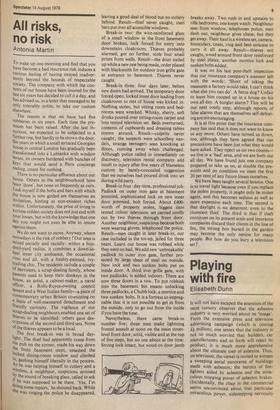Playing with fire
Elisabeth Dunn
It will not have escaped the attention of the most cursory observer that the asbestos industry is very worried about its 'image'. From the extensive press and television advertising campaign (which is costing £1 million), one senses that the industry is not so much worried that builders, car manufacturers and so forth will reject its product; it is much more apprehensive about the ultimate user of asbestos. Thus, on television, the viewer is invited to witness a sweeping aerial panorama of buildings made with asbestos; the heroics of firefighters aided by asbestos and the miraculous stopping power of asbestos brakes. (Incidentally, the chap in the commercial seems unconvinced about that particular miraculous power, sidestepping nervously to dodge the oncoming vehicle.) In the newspapers, readers are offered a simple, question-and-answer, told-to-thechildren guide to the wonders of asbestos. In other words, at considerable expense, the asbestos industry is persuading all users of ironing boards, simmering pads and whatever that there is nothing to worry about. Its mouthpiece is the Asbestos Information Committee which, although it sounds like an official body, is an industry-financed public relations outfit.
It is hardly surprising that in all this welter of persuasive talk, small critical voices have been raised. On 4 July, the Sunday Times published an article demolishing, point by point, a lot of the Asbestos Information Committee's carefully-worded arguments. By 25 July, the wording of the full-page advertisement (carried by the Sunday Times despite its earlier dissection) had changed somewhat, though the tone remained soothing: 'There is also greater risk of lung cancer with exposure to asbestos dust, particularly if you smoke heavily. But, as far as is known these illnesses have occurred in people who have been exposed to asbestos dust for many years.' The Sunday Times had already pointed to the Department of Health Standing Medical Advisory Committee's dictum that 'cancer can be produced by "slight exposures [to asbestos] and on present knowledge we must assume that no amount of exposure is free from risk."
Meanwhile, readers have been responding to the Advertising Standards Authority's invitation: 'Legal. Decent. Honest, Truthful. If you see an advertisement which isn't, tell us.' The ASA has been inundated by critics of the ads who think that they are none of these, and it has instigated an inquiry.
An ASA inquiry is a fairly thorough business in that it checks all the claims made by an advertiser and then gives the advertiser a chance to state his own case. If he cannot substantiate his claims adequately, he is asked to withdraw his advertisements. The ASA has no power to force changes or demand an end to a particular campaign.
While such an inquiry is undeniably admirable in its aims, it is not altogether to the disadvantage of the advertiser. For while it is in progress, his critics are effectively silenced while he is free to continue to make the same, possibly shaky claims, until the Authority has completed its deliberations and made a decision one way or the other. Thus, the ASA is, at present, unprepared to say anything about its inquiry; the Government's Health and Safety Executive. which has been heavily critical of the asbestos ads in the past, has been asked to give its views to the ASA and will therefore not commit itself to further comment until the results of the inquiry are published.
In the nature of things, this will probably be long after the Asbestos Information Committee has spent its EA million and the



























 Previous page
Previous page